Pomeranians are one of the most diverse breeds around, sporting various colors like white, orange, and brown. One of the most sought-after of those, however, is black. This color variation isn’t recognized as a separate breed from other Poms, but actually, represents one rare and much-desired color variant.
Other than the striking coat, these pups have all the same characteristics as the others. Pomeranians remain the most popular and beloved of the toy breed, as their intelligence, loyalty, and larger-than-life personalities make them an excellent addition to families.
In this piece, we look at Pom history, as well as the genetic makeup and more of the highly sought-after Black Pomeranian. The black coat color is rarer for the Pom, so let’s find out what you can expect when you start your puppy search!
Breed History
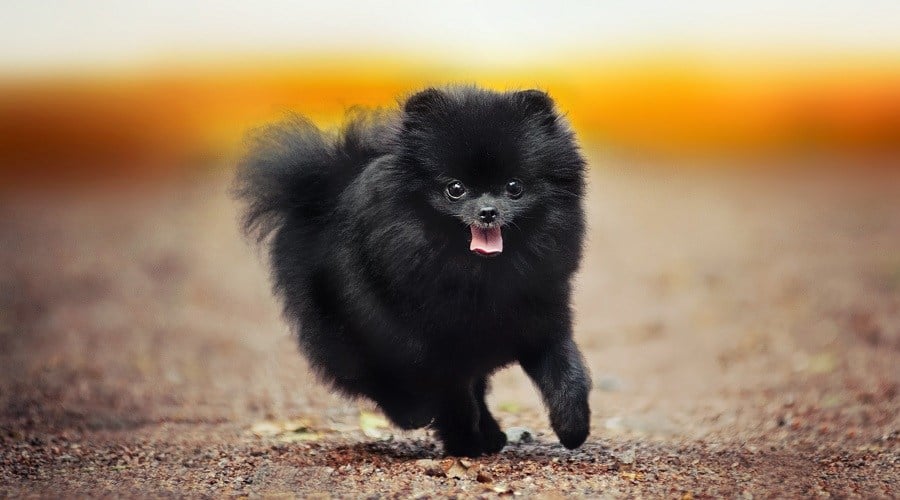
To understand why the black Pomeranian is so rare, looking at the history of the breed is essential. Poms are members of the Spitz family which includes the Samoyed, the Elkhounds, and other sled-pulling and working dogs.
The German Spitz eventually was bred down to the size of thirty to thirty-five pounds. This smaller Spitz became associated with the Pomerania region of Poland and Germany, leading to the origin of the breeds name.
These dogs have been seen on various artifacts dating as far back as 400 B.C. The Spitz breeds lived throughout Europe and Asia and were known for their pricky ears, thick double coats, and tails that curl up their backs. You can probably think of multiple dogs that fall under that label: German Shepard and Huskies, to name a few. The Poms were bred to be smaller and more compact.
Before the 15th century, the Spitz name wasn’t actually used. The name “Chien-loup” (wolf-dog) was used instead, and it’s thought that the French phrase “Lou-Lou” (darling), was derived from this name. Historians can’t find any records of the Spitz name before George 111th in England, so it’s likely the name wasn’t changed until later.
The most widely thought origin is from Pomerania, as previously mentioned. However, multiple breeds throughout Europe have no connection with Pomerania or Germany at all. France called them Lili, Chien de Pomeranie or the Lou Lou, while in Holland they’re named Wolfshond or Keeshond as of the 1780s. Italians call these cuties the Italian Spitz, Florentine Spitz, Lupino, Cande de Quirinale, and the Volpino. The Italian variety is typically found in a striking orange or yellow color.
Rise in Popularity
The 18th century saw the rise of the Pomeranian, or the wolf-dog in England due to fascination from English royalty. In 1761, King George 111th marriage to Queen Charlotte not only included her but her pet wolf-dog who was white in color. This specific breed of Pom did originate from Pomerania and thus she called it a Pomeranian. We know that these dogs were kept as pets as seen in various paintings of royals and nobles.
William Taplin Discussed the Breed in Detail in 1803, “The Sportsman’s Cabinet”:
“POMERANIAN; or, WOLF-DOG. The dog so called in this country is but little more than eighteen or twenty inches in height, and is distinguished by his long, thick, and rather upright coat, forming a most tremendous ruff about the neck, but short and smooth on the head and ears; they are mostly of a pale yellow, or cream-color, and lightest on the lower parts.
Some are white, some few black, and others but very rarely spotted; the head broad towards the neck, and narrowing to the muzzle; ears short, pointed, and erect; nose and eyes mostly black; the tail large and bushy invariably curled in a ring upon the back. Instances of smooth, or short- coated ones are very rarely seen; in England he is much more familiarly known by the name of fox-dog, and this may originally have proceeded from his bearing much affinity to that animal about the head; but, by those who in their writings describe him as a native of Pomerania, he passes under the appellation of the Pomeranian-dog.”
Black Pomeranian Rarity

William Taplin mentions the pure black Pomeranian as a more rare version of the yellow, cream, or otherwise lighter variant. However, they were common enough to be noted which leads historians to believe that they were more common than they are today. The black coat likely originated from the German Spitz specifically as they provide the bulk of their genetic makeup. They are frequently seen with an all-black coat and were more common back in the 17th century than they are now.
Pomeranians have also become popular in recent years when it comes to mixing with other breeds. This is difficult because of the size, but breeders have found ways around that as evidenced with the creation of the Pomsky.
Black Pomeranian Overview
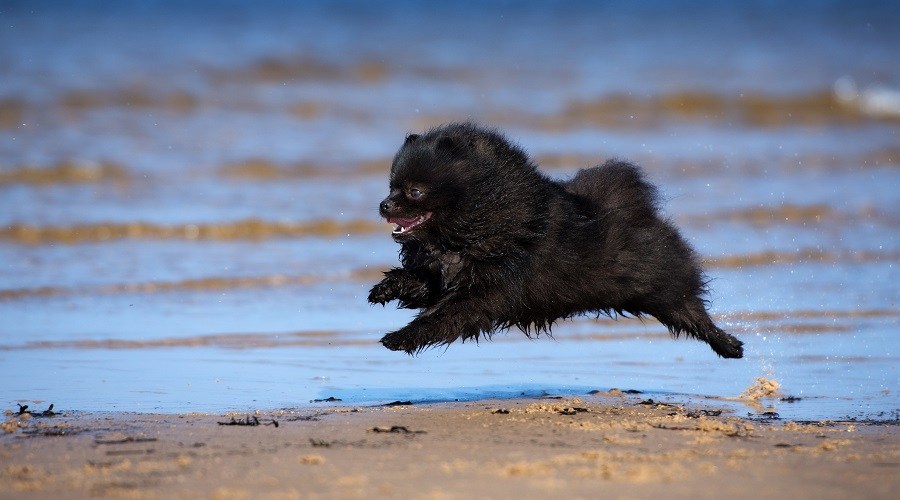
The black Pom was a commonly found breed when it was first discovered. They weren’t considered rare at all, but with increased breeding pure black Poms became rarer and rarer. It is now more common to find the orange/yellow variants than any other color. Though it is still possible to breed black Pomeranians, it is difficult to get a completely black one as they are often found with different colors on their coats.
The surest way to get a black variant is to breed two black Poms together. It is still incredibly challenging to get a pure black variant even with two entirely black parents as the breeds DNA has so many colors within that it wouldn’t be unusual to see a white litter from black puppies.
Temperament

Poms are generally perky, friendly dogs that don’t realize they’re small and will often tackle or verbally threaten dogs much larger than them. This doesn’t mean that the Pom is naturally aggressive; they just like to show off to their owner how big and strong they are. Due to their lively attitudes, they require daily exercise – but only a walk around the block.
They’re independent and can be left alone once they reach adulthood. They’re intelligent and obedient little lap dogs. Not only that, but they make good alarm dogs – you’ll always know if someone is outside the door as they love to bark at people who pass by. Pomeranians are also good with children, though they should exercise caution as the Pom isn’t as sturdy as larger dogs.
Grooming

Pomeranians have to be groomed similarly no matter what color they are. They all experience seasonal shedding in early summer and winter, so it’s essential to brush your Pom multiple times a week as this happens. Still, their double coat requires daily maintenance to keep their coat healthy and sleek. If you start finding a lot of hair throughout the house, that’s an excellent cue to brush them more.
Training

Training a Pom means a lot of socialization. Take your pet out with you wherever you go to make sure they don’t get shy or aggressive around strangers or other animals.
Most Poms have no issue with confidence – their barking is going to be the biggest habit for them to unlearn. It’s best to get this nipped in the bud immediately to avoid long-running issues. Crate training should also be prioritized. Since they’re small, they may need to go into their crate a lot to avoid bigger animals or people.
Exercise

These dogs love to run! Since your Pom is black, it’s best to not keep them out in the sun too long as they will become hotter quicker. Watch their paws on the pavement as well and pick them off often in extreme temperatures to avoid them getting burnt. All they need is one to two 30-minute walks per day to stay healthy and happy. A short walk around the neighborhood or fetch will do the trick.
Nutrition

This breed doesn’t require much to eat. Being small has its advantages! Watching their weight is important, though as it doesn’t take much for them to become uncomfortably obese. However, they have quick metabolisms and burn energy really quickly – it’s a good idea, in general, to watch how much they eat. Since male and female Poms are around the same size, it’s easier to determine food amount by pounds
- 1/2 cup for 1-pound puppy
- 1 cup for 3-pound puppy
- 1 and 1/2 cups for 5-pound dogs
- 2 cups for a 6-pound dog
Adjust according to their needs. Make sure not to feed them before bed as they’re more likely to bloat. Frequent meals throughout the day are better for them then one large meal as they have an easier time pacing themselves. If you’ve recently adopted or plan to adopt a Pom, we’ve compiled a full list of excellent dog foods that most Pomeranians will love.
Health
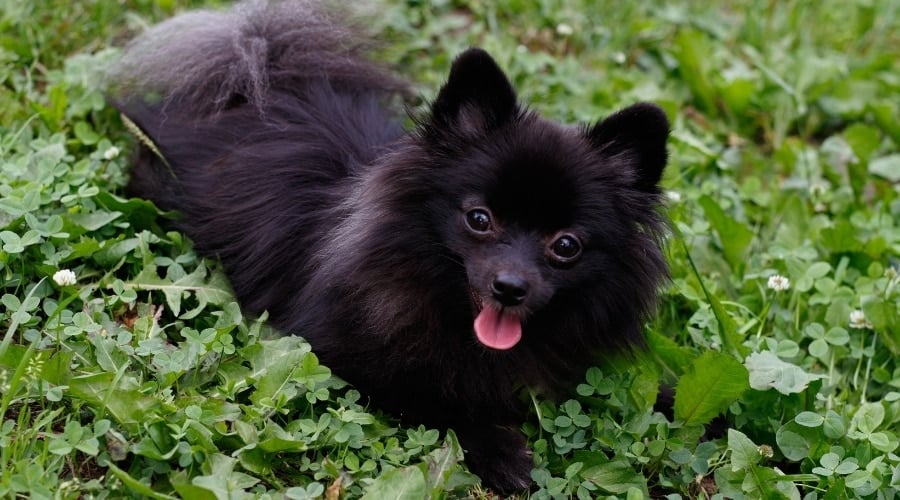
Small dogs suffer from similar issues, such as dental problems, hypoglycemia, tracheal collapse, and chronic valvular disease. However, there are Pomeranian specific diseases which include:
Distichiasis: A congenital condition that causes eyelashes to develop an extra row.
Entropion: When the bottom eyelid rolls inwards.
Luxating Patella: When the alignment of the hind legs is abnormal.
Alopecia: Hair loss.
Hypothyroidism: An autoimmune disease that results in a low metabolism.
Patent Ductus Arteriousus: A heart defect.
Most of these are relatively uncommon, except for patellar luxation which can occur as your Pomeranian gets older. Just watch for the buckling of the knees or a limp while walking. If you notice this, take them to the vet immediately as they may require surgery.
Living With a Black Pom
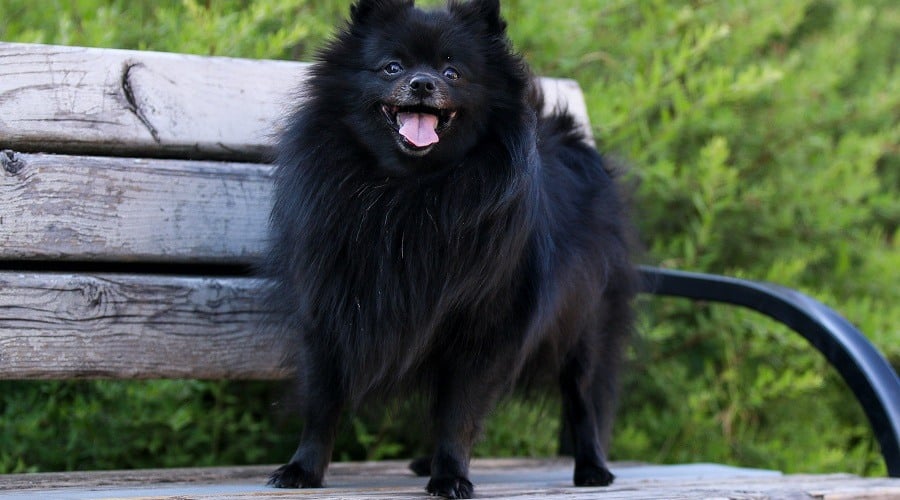
Generally easy to keep, Pomeranians are good pets to have in the home and don’t require a lot of extra attention. Although some are finicky eaters, they’ll typically warm up to the food that’s placed in front of them. The double coat will require regular grooming at least once or twice a week, with daily brushing sessions.
Though small, they do need regular exercise and thrive on training. They’re intelligent and learn quickly, and love to perform tricks. It’s one of the reasons they’re such a hit at shows. They’re usually friendly with other, smaller dogs but are likely to be intimidated by larger breeds and will bark at them if they feel threatened.
If you have children, it’s better to buy them as puppies so they can warm up to them. This doesn’t mean they’re bad with children, but they tend to be more reserved if bought older. Tell small children in your household to be patient with them, as they are small and easily frightened.
Pomeranians make excellent watchdogs and will bark loudly at anyone passing the house or coming in. They primarily make good companions for the elderly due to their alertness and small size.
Spotting a Black Pomeranian

A black Pomeranian puppy is easy to spot. Their large double black colored coat that extends far past their tiny bodies. However, it is difficult to know for sure if the Pom you’re looking at is a pure black without breeding paperwork and history.
You’ll notice this variation of the breed right away from the puffiness of its coat. The double coat will be thick and fluffy underneath and longer and straighter over the top. The coat will have a coarse texture when pet. Poms come in many colors, including cream, white, orange, sable, red, brown, black and the rarest of all, blue.
These colors are found as a solid color (the rarest), single-color coats, or a bi-colored or particolored coat which is mostly solid with marking of another color. Brindled Poms and merle Poms are the most unique of all, sporting interesting patterned colored combinations.
To know if your Pomeranian is genuinely black, you need to make sure there are no patches or stripes of another color. It’s common to see mostly-black Poms with white, tan, or brown patches, known as a “mismark.” Any combination of Pom is possible, but as long as your pet has a little bit of another color on its fur, it isn’t considered a pure black Pomeranian.
Black as a Competition Color

Although it’s interesting to see a black Pomeranian in competition due to its rarity, they aren’t standard. A parti-colored of mis-marked black Pom will still be eligible to compete in all breed-specific competitions unless these Poms have a merle gene with blue eyes. Competition standard insists Pomeranians must have dark eyes.
It should also be pointed out that merles aren’t allowed by many breed organizations and kennel clubs outside of the U.S. This genetic deformity is fascinating to look at and doesn’t cause the breed any issues besides a variant coat color; they just aren’t allowed in competition.
The black Pom also needs to have their points such as their lips, nose, rim around the eyes, and pads to be black. This is incredibly rare and will often disqualify the perfect black Pom from the competition if these points are of any other color.
Award-Winning Black Poms
In the past 100 years, many black Pomeranians have won top awards over multiple competitions. One of the earliest was in 1911 when Mrs. Frank’s Prince Charming won the Best of Breed award. Breeding black into the oranges and red of the Pom enhances the color clarity of the coat and improves the pigmentation in only one generation. If you wish to breed this color back in, you’ll have to skip to the next children.
This is mentioned as black Poms are often overlooked at dog shows. Typically orange and orange sable are more popular, as black Poms are more challenging to prepare before shows. This doesn’t mean they don’t win competitions – as they often do. However, adding more colors to the Pom seems to be more advantageous currently.
Puppy Prices
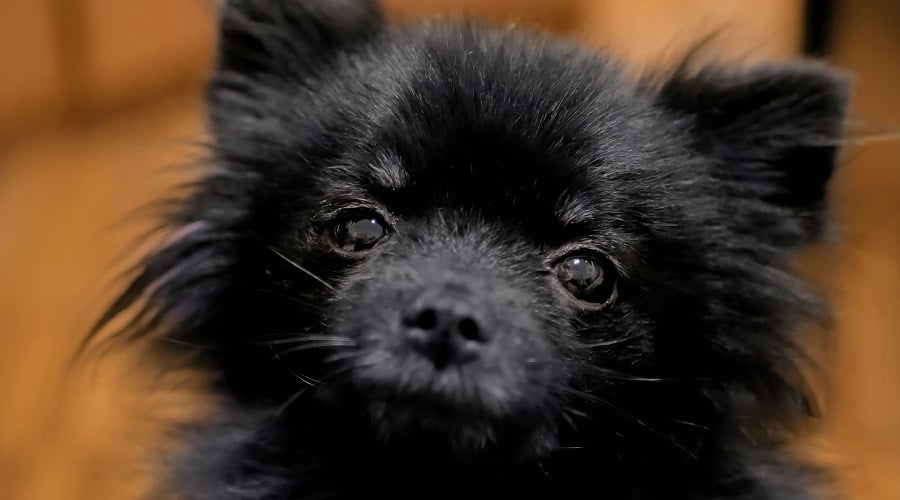
Finding a reputable breeder is the most likely way you’ll find a black Pom. If you can find one at a local animal shelter though, it will save you a large chunk of change. As mentioned, it is difficult to know for sure if the Pom is healthy and pure black even from a breeder, but you’ll have a better chance this way.
You won’t find these rare dogs for anything less than $800. However, the licensed dogs will often come at a higher price that could range between $1,000-$2,000, but it may be worth it for you if you’ll be sporting your new friend in a competition. If you see anything outside this range; be cautious.
As with any industry, some breeders are only in it for the money. They aren’t truly in the business for the health of your puppy. The most common scam you’ll come across is breeders charging a premium for what is called a “black teacup” or “black toy” Pomeranian. Poms are already small dogs. The term mini, teacup, or toy is concerning as it usually means they’re bred to be less than standard (four to seven pounds) which isn’t healthy in the long term.
Your “Teacup” may not be small for long! Another common scam is when the Pom is advertised as small, teacup, or toy when they aren’t. The breeder will likely ask you to pay more than usual for a Pom. To avoid this, research the parents of any puppy you purchase beforehand. If the breeder won’t let you do this, it’s likely a scam.
Final Thoughts
Although there is no difference between a regular Pom and a Black one, the rareness and beauty of their coat make them attractive to breeders, and are great show stoppers at a competition.
If you’re thinking of getting a tiny dog and don’t mind regular stops while walking them (they’re cute, you’d want to pet them too), the black Pom will be a great addition to your family.

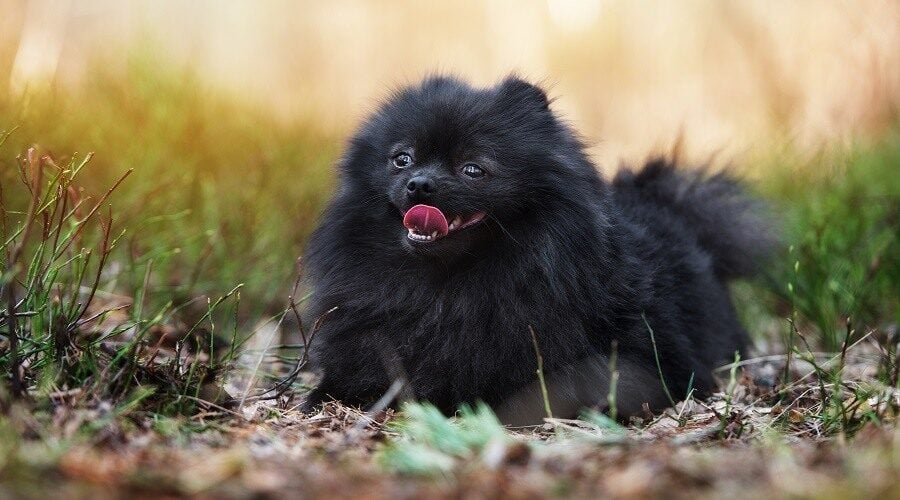




I have a beautiful black pom ‘Sammy’ he is a show stopper. He has a patch of white on his chest which I call it his tuxedo. Every time I take him on a walk or anywhere I get stopped. He is so full of life and personality. Black pom’s are unique and they seem to know it. He marches around like a mini napoleon and can’t be ignored. Super intelligent and best companion dog I’ve ever had!
We found my Dämon (German for demon) at a once a month trades days thing here in Texas. He is pure black but I was wondering if the “mis-mark” could move? He had a couple white hairs on his foot when we got him that disappeared, then a couple white hairs under his tail that, again, disappeared, and THEN a thin white line above his lip that has AGAIN disappeared…I check him weekly for new white patches but since the one above his lip has gone away I haven’t found anymore. He is almost 2 years old.
I have the most amazing temperament 8 month old Pomeranian. She so lovely I’d like another to keep her company if we go out and for her to generally have a playmate. Will bringing another puppy into the house spoil our first puppies nature and make her more yappy?
Hi Chris! While there’s no way to guarantee how your pup will act, we always think that 2 dogs are better than one. Our pups definitely encourage each other to bark, but we’ve worked to mitigate that behavior through obedience training. If you do decide to adopt, we always recommend getting a dog that’s the opposite sex of the one you have. Things can get competitive when you have two of the same gender under one roof. Hope this helps!
Our black Pom, Bella, was a rescue dog acquired from an Alzhiemer’s patient no longer able to care for her. Bella weighs 11.5 lbs. and is a remarkable addition to our home. She survived a pancreatitis scare, is the most lovable personality and will hopefully continue to have plenty of healthy years ahead of her. Unfortunately, we have no background information (breeding-wise) on Bella, however, she is pure black from paws to head and has the most luxurious coat of any dog we have ever seen. Her lustrous thick hair, handsome face, pointed ears, stature and sparkling eyes make us think of how well she would have developed into a show dog! Intellectually, Bella seems to understand every communication and is truly a best friend who is well loved.
Sounds like a great pup, thanks for the comment Russ!
My Pom is solid black other than a tiny bit is white hair under bottom lip. Is he considered a true black pom?
Hi Shirley – a little bit of white is considered a “mismark” but is generally acceptable. Thanks for stopping by to comment!
We have a black Pomarain in Sydney Australia. Your description of the breed could have been written about him. It was spot on. We bought him for $1000 nearly 16 years ago and he has been the most wonderful little boy. He’s an old man now but still has all those cheeky traits that have made him the centre of our family.
Thanks for the comment Vincent – sounds like an amazing pup!